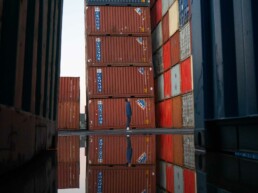Navigating Supply Chain Volatility in 2023
In an era marked by continuous disruptions and labor negotiations, the 2022 Council of Supply Chain Management Professionals (CSCMP) State of Logistics report revealed a startling fact: United States business logistics costs accounted for 9.1% of the GDP. Amid this backdrop, the logistics industry witnessed a significant upturn even as the national economy grappled with uncertainties. Supply chain volatility in 2023 is a huge factor for the economy both for consumers and vendors. Here is what you need to know.

Root Causes of Supply Chain Volatility in 2023
The session, moderated by Kevin Smith, the president, and CEO of Sustainable Supply Chain Consulting and CSCMP chairman of the board, explored the root causes of this volatility. Smith cited the demise of LTL carrier Yellow Corp., the UPS-Teamsters negotiations, and the ongoing talks between the United Auto Workers and the ‘Big Three’ automakers, among other factors. These factors have collectively contributed to the turbulence experienced in the industry.
Chaos in the Supply Chain
Paul Bingham, the director of transportation consulting for S&P Global Market Intelligence, underlined that the 9.1% logistics GDP figure reflects the amalgamation of ongoing disruptions, including inflation and the Federal Reserve’s efforts to combat it. These disruptions span various aspects of business operations, from labor challenges to substantial declines in transportation rates and the recent surge in fuel prices. These elements have significantly impacted the overall performance of the logistics sector.
Rising Costs and Uncertainty
Interest rates, the cost of capital, and inventory carrying costs have surged to their highest levels in years for many industry stakeholders. These factors play a crucial role in decision-making processes, affecting inventory policies and both consumer and business-related choices. This, in turn, has contributed to the freight recession experienced throughout the year. The prospects of a swift recovery are strongly influenced by interest rates and the costs of capital across the entire economy.
Shippers’ Perspective
From a shipper’s perspective, Chris Jackson, the vice president of operations & IT for Chevron North America, holds a cautious outlook. He anticipates that volatility is here to stay, and there are no quick fixes in sight. According to Jackson, the key to managing this volatility is to position your company as a shipper of choice. While this may sound straightforward, it involves a multitude of tasks, including a deep understanding of your freight, including its classes, weights, and dimensional factors.
The Role of Resilience
Jennifer Kobus, the vice president of transportation & logistics for Ulta Beauty, emphasized the need for resilience and strong partner relationships when navigating supply chain volatility. She stated, “These attributes are extremely critical. We have been dealing with volatility for the last few years, which requires resilience. The name of the game is really about contingency planning. It is absolutely critical. We have learned that the ability to be resilient and adapt quickly necessitates a well-structured set of plans. This includes establishing strategic partnerships and collaborative relationships with the carriers you work with, beyond the annual RFP process.”
Potential for Stability
While supply chain volatility remains a constant challenge, Greg Javor, the senior vice president of global supply chain operations for Mattel Inc., envisions a potential return to pre-pandemic levels, as rates approach their pre-pandemic norms. Javor emphasized that, in most cases, annual bidding is no longer sufficient, and ongoing adaptation is necessary, given the unpredictable nature of the industry.
3PL Sector Insights
Penske Senior Vice President of Sales and Solutions Andy Moses, representing the 3PL sector, emphasized that volatility drives close collaboration and serves as a necessary component of achieving positive outcomes.
Market Dynamics
From a market perspective, Moses views the economy as a “sleeping giant” of sorts. “When I look at the underlying costs of transportation, they are not dropping,” he said. “Rates may have dropped a bit, but costs have not dropped. Equipment, labor, insurance, in particular, and rates might have dropped a bit. Any 4% to 5% increase in activity is going to be felt quickly. I do think there is more volatility coming with any help at all from the economy.”
2023 eCommerce Sustainability: Best Practices for a Greener Future
With the growing concern for our planet’s well-being, it’s crucial for online businesses to adopt sustainable practices that not only drive profits but also contribute to a greener future. In this blog post, we’ll delve into the best eCommerce sustainability practices for 2023 and beyond, helping you thrive while being environmentally responsible.
Read More…
In the face of supply chain volatility, staying agile, knowing your business inside out, and forming strong partnerships emerge as the tools to weather the storm. The path ahead is uncertain, but with the right strategies, businesses can thrive amidst the chaos. Supply Chain Volatility 2023 remains a challenge, but one that can be overcome with resilience and adaptability.





